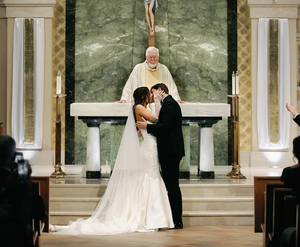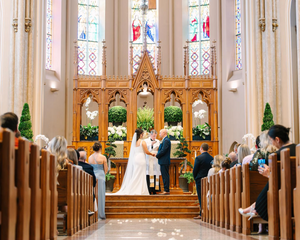You may also like
Wedding traditions carry rich layers of history, symbolism, and personal meaning, and the wedding veil is a profound example. The Wedding Veil has been used in many different contexts for various faith traditions and spiritual communities, which you can read about here.
Understanding the wedding veil in the Christian religious context in particular can help modern brides understand how the tradition has developed and the reference point for particular ideas they may associate the wedding veil with. Explore our collection of spiritually-inspired wedding veils at https://tarabridal.com/. Let us help you choose a veil that honors both tradition and your personal faith journey.

Bride: Mackenzie Murph - Arkansas, USA. Veil: Kaitie from Organza wedding veils collection. Photo: Laura Powers
In this blog, we’ll uncover the biblical perception of the wedding veil, a symbolism of purity and transformation, and ways modern Christian brides can honor its meaning. Discover how this timeless accessory represents not only beauty but also has been used as part of a cherished spiritual heritage where it embodied devotion and faith.
A Symbol of Purity and Humility
The tradition of veiling can be traced back to the early Church. In biblical times, women commonly covered their heads, especially in worship settings, as a gesture of modesty and humility before God. This practice wasn’t exclusive to brides; it was a cultural norm.
For a Christian bride, wearing a wedding veil embodied this heritage of humility and purity. Many saw the veil as a symbolic representation of purity—covering herself as a modest bride before the wedding ceremony, in preparation for the sacred covenant she was about to enter.
Interestingly, this modesty was not only toward her spouse-to-be but also symbolized her reverence for God. In the Christian faith, the covenant of marriage was not only a union between two people; but a spiritual commitment to live a life aligned with God’s teachings.
The veil, in this sense, served as a reminder that she and her partner were approaching God’s altar with reverence and open hearts. Thus, the wedding veil’s Christian meaning went beyond its material form, signifying an internal state of readiness and humility.

Bride: Mackenzie Murph - Arkansas, USA. Veil: Kaitie from Organza wedding veils collection. Photo: Laura Powers
The Veil and the Concept of Transformation
Beyond modesty, veiling in the Christian tradition spoke to the transformation that marriage brings. A bride walking down the aisle, veiled, is in a beautiful transition from her previous life to one shared with her spouse.
In the same way, Christian teachings emphasized that marriage is transformative, molding both partners toward mutual love and spiritual growth meant to last a lifetime. Covering the bride’s face until the moment she is joined with her partner is often seen as symbolic of that transformation. The unveiling, then, became an outward symbol of new life.
For Christians, the symbolism of lifting the veil is still powerful. The moment the groom unveils his bride is seen by many Christians as a representation of the purity and vulnerability in marriage, as they begin this new chapter without secrets or reservations. The practice of unveiling the bride dates back to the ancient Roman Empire, and continued as Christianity developed.

Bride: Paulina Leal - Zapopan, Mexico. Photo: danielagtzh.com. Veil: Lilly from Floral veils collection.
A Gesture of Submission and Devotion
In Christian scripture, Paul writes in his letters to the Corinthians about head coverings as a sign of honor and submission. Although cultural perspectives have evolved since then, the wedding veil’s can still be viewed in a religious context as an expression of mutual respect and devotion in marriage.
The act of veiling does not imply inferiority but represents the bride’s choice to respect and honor her marriage vows. Likewise, the partner’s role in unveiling their bride reflects a commitment to be a caring, responsible partner, upholding his/her side of the covenant with humility and love.
While the veil at one time symbolized submission, it also captured the essence of Christian marriage—where both partners are devoted to nurturing a love that’s centered on faith and trust. Far from being a one-sided act, the veil’s symbolism speaks to the mutual devotion that is central to many Christian unions, where both individuals uplift one another. For some, it’s this spirit of submission to each other and to God that the veil ultimately embodies, serving as a reminder of the unity that marriage brings.
Echoes of Sacredness: Veils in Religious Spaces
For centuries, the Christian tradition has regarded the veil as a symbol of holiness and respect, not only in marriage but in religious settings. The practice of wearing veils to church stems from these deep spiritual roots. Think of Moses, who veiled his face after encountering God's glory, or the Temple veil in Jerusalem, which separated the Holy of Holies from the rest of the temple.
When Jesus died, the tearing of this veil marked a new beginning, symbolizing direct access to God for all believers. Just as the Temple veil represented the barrier between humanity and the divine, the wedding veil creates a sacred space for the bride, an intimate sanctuary she shares only with her spouse once unveiled.
In this way, the wedding veil is often thought of as a piece of sacred clothing, symbolizing the bride’s unique relationship with God and the covenant she is entering into. It can mirror the respect and reverence that believers are encouraged to show within religious spaces. To wear a veil as part of the Christian wedding tradition honors this sacredness, making the wedding ceremony a spiritual experience as much as a joyous celebration of love.
Honoring God through the Ceremony
Traditionally, Christian marriage isn’t simply about the love between two people; it’s about honoring God’s presence in that union. Every aspect of the Christian wedding ceremony, from the vows to the veil, is steeped in a desire to acknowledge God’s guidance. The wedding veil, specifically, is one of the most visible symbols in the ceremony. When a bride wears her veil, she acknowledges that her love story is a part of a larger story in her personal journey with god.
Many brides find that the wedding veil adds a quiet beauty and reverence to the ceremony that reflects this spiritual dimension. Walking down the aisle with a veil covering her face and later removing it with her partner honors God in a subtle yet meaningful way. This act serves as a humble reminder that marriage is not solely about individual happiness; it can be about building a life in which God’s love, guidance, and purpose are present. The wedding veil’s Christian symbolism thus can invite the bride to embrace this journey with both love and faith.

Anna Dietrich, MI USA. Photo: Veil: Cassandra from Beaded wedding veils collection. Photo: Lydia Charles
Practical Tips for Selecting a Wedding Veil with Christian Symbolism
If you’re a bride who wants to embrace the wedding veil in a Christian fashion, here are some tips for selecting one that complements both faith and your style:
- Choose a Traditional Style: Cathedral veils, mantillas, and other longer veils often carry a more traditional and formal feel, and were traditionally used in Christian ceremonies in the past.. These styles have an air of elegance that resonates with the religious overtones a bride may be seeking.
- Consider Modesty and Elegance: When choosing a veil length, consider its modesty and your religious context. A longer veil often covers more, creating a visual representation of the bride’s humility and readiness for the holy sacrament of marriage.
- Incorporate Symbols of Faith: Some veils include lace, cross details, or other faith-based embroidery. These subtle touches can personalize your veil to reflect various Christian faith traditions and belief systems, making it a unique reminder of the spiritual aspects of your union.
- Prepare a Prayer or Scripture Reading for Unveiling: Some brides find it meaningful to include a short prayer or scripture reading right before or after the unveiling. This act reminds the couple and their guests that their union is grounded in faith and surrounded by divine love.
- Reflect on Its Meaning During the Ceremony: As you wear your veil, take a moment to reflect on its symbolism and what it means to you personally. Whether you’re walking down the aisle or standing at the altar, let the veil’s meaning serve as a reminder of the values you carry in your daily life and in your journey with the holy.
Embracing the Spiritual Essence of a Wedding Veil
The beauty of the wedding veil lies in its many layered meanings, connecting modern brides to the age-old traditions which include Christian faiths. By understanding the wedding veil’s meaning in a Christian context, you’re better able to appreciate one of the spiritual aspects it can bring to your ceremony. The veil is more than an accessory; sometimes it’s a symbol that honors purity, devotion, and reverence for the divine. And as you lift that veil, let it be a moment that unveils not only your face but also your heart—open to the journey of love, faith, and partnership ahead.

Bride: Haley Bethel - Georgia, USA. Photo: signaphotocollective.com. Veil: Jesi.
For modern brides trying to better understand the history of the wedding veil, and the wide variety of symbolism they can apply in their wedding, these perspectives offer a plethora of options.
The veil may hold a significance to you that lives outside of the realm of your partner and yourself. It may be part of your journey with what you find holy. It may represent the spiritual devotion your marriage entails to you. Whatever the case, better understanding how the meaning of the wedding veil has developed over the centuries can only deepen your connection and understanding of how this wedding will represent you, your partnership, and the values you bring into it.
If you're interested in exploring further how the wedding veil has been used in a variety of spiritual and religious contexts, we invite you to read our additional blog post on the spiritual significance of the wedding veil: What Does the Veil Mean Spiritually?








